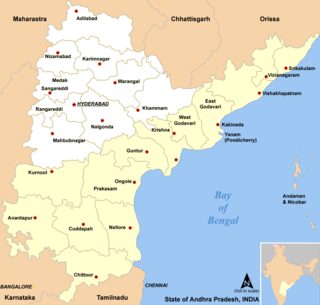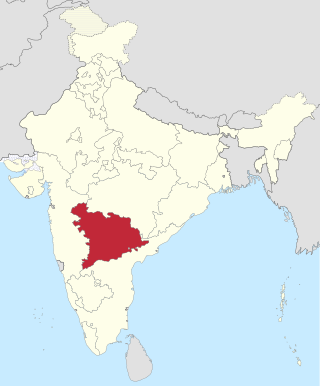
The All India Majlis-E-Ittehadul Muslimeen is an Indian political party based primarily in the old city of Hyderabad. It is also a significant political party in the Indian States of Telangana and Maharashtra. It is the second largest party in Telangana Legislative Assembly and in Telangana Legislative Council. Its aim is to promote the social, economical, and educational development and effective representation of Indian Muslims and Dalits.

Operation Polo was the code name of the Hyderabad "police action" in September 1948, by the newly independent Dominion of India against Hyderabad State. It was a military operation in which the Indian Armed Forces invaded the Nizam-ruled princely state, annexing it into the Indian Union.

Bolarum is a locality in Secunderabad Cantonment in Hyderabad, Telangana, India. It is in the Hyderabad Metropolitan Region. The distance from Bolarum to Secunderabad is 10 km.

Syed Kasim Razvi was a politician in the princely state of Hyderabad. He was the president of the Majlis-e-Ittehadul Muslimeen party from December 1946 until the state's accession to India in 1948. He was also the founder of the Razakar militia in the state. He held the levers of power with the Nizam of Hyderabad, blocking the possibilities of his accommodation with the Dominion of India.

The Razakars were the paramilitary volunteer force of the Muslim nationalist Majlis-e-Ittehadul Muslimeen (MIM) party in the Hyderabad State under the British Raj. Formed in 1938 by the MIM leader Bahadur Yar Jung, they expanded considerably during the leadership of Qasim Razvi around the time of Indian independence. They were deployed in the cause of maintaining Muslim rule in Hyderabad and resisting integration into India. Described as "enthusiastic" and "undisciplined", they targeted Hindus as well as Muslims whose loyalty was in question. They also fought communists who were launching a revolution in the state.
Hyderabad-Karnataka Liberation Day, officially known as, Kalyana-Karnataka Liberation Day is an annual festival celebrated in seven districts like Bidar district, Kalaburagi district, Yadgir district, Raichur district, Ballari district & Koppal district, Vijayanagara district of Karnataka state, India. It takes place on 17 September. The festival celebrates the annexation of Hyderabad by India in 1948 following the Partition of India and rebellions in Hyderabad State.
The Telangana Rebellion popularly known as Telangana Sayuda Poratam of 1946–51 was a communist-led insurrection of peasants against the princely state of Hyderabad in the region of Telangana that escalated out of agitations in 1944–46.

Maa Bhoomi is a 1979 Indian Telugu-language social problem film directed by Goutam Ghose in his debut. The film is produced by B. Narsing Rao, who also wrote the film with Goutam Ghose. The film is based on the novel Jab Khet Jage by Krishan Chander on the Telangana Rebellion in Hyderabad State. It depicts a typical life of villagers under feudalistic society in the Telangana region. The film features Sai Chand, Rami Reddy and Telangana Shakuntala in pivotal roles. The plot follows Ramayya, a landless peasant who joins the Telangana Rebellion of 1948.

Konda Venkata Ranga Reddy was an Indian statesman and activist served as the first Deputy Chief Minister of Andhra Pradesh from 1959 to 1962. He is a freedom fighter who fought the Telangana Rebellion against the Jagirdars. The Ranga Reddy District in Telangana is named after him.
Anabheri Prabhakar Rao was a Telangana communist guerrilla leader and is also considered a foremost authority of the Telugu language. He was an Indian freedom fighter, considered to be one of the most influential revolutionaries of the Indian independence movement. He was an intellectual, military theorist, diplomat and major figure of the Telangana Rebellion. He died fighting against the Nizam and Razakars.

The history of the Telangana movement refers to the political and social conditions under which the Telangana region was merged with Andhra State to form the state of Andhra Pradesh and the subsequent demands to reverse the merger to form a new state of Telangana from united Andhra Pradesh.
Muzaffarabad massacre was the massacre of the residents of predominantly Hindu village of Muzaffarabad now under Kharna Union of Patiya Upazila in Chittagong District of Bangladesh on 3 May 1971 by the Pakistani army aided by the local collaborators. An estimated 300 Bengali Hindus, from 5-year-old child to 80 years old men and women were killed in the massacre. More than 500 houses were burnt to ashes. According to eyewitnesses, Rameez Ahmed Chowdhury, the then Chairman of Kharna Union, and his aides were responsible for the massacre.

Hyderabad State was a state in Dominion and later Republic of India, formed after the accession of the State of Hyderabad into the Union on 17 September 1948. It existed from 1948 to 1956.

The history of Telangana, located on the high Deccan Plateau, includes its being ruled by the Satavahana Dynasty, the Kakatiya Dynasty (1083–1323), the Musunuri Nayaks (1326–1356), the Delhi Sultanate, the Bahmani Sultanate (1347–1512), Golconda Sultanate (1512–1687) and Asaf Jahi dynasty (1724-1950).
Gorata is a place in Bidar district of Karnataka, India. In 1948, the youth of Gorata wanted to hoist the Indian flag. The village was ruled by the Nizam of Hyderabad. The Nizam didn't want to accede the Hyderabad region to India but rather wanted an independent nation for which he had set up a militia known as the Razakars with an objective to prevent an accession to India.

Marathwada Liberation Day, also known as Marathwada Mukti Sangram Din is celebrated in Maharashtra on 17 September annually. It marks the anniversary of Marathwada's integration with India when the Indian military, liberated State of Hyderabad, and defeated the Nizam on 17 September 1948, 13 months after Indian independence.
The Parkala Massacre was the killing of 22 Hindus on 2 September 1947, by the Nizam of Hyderabad's police and the Razakars in the town of Parkala. The massacre suppressed the popular movement for India to annex the Hyderabad State.

The Hyderabad Massacresof 1948 refers to the mass killings of that took place in the aftermath of the Indian annexation of Hyderabad. The killings, perpetrated by local Hindu militias assisted by the Indian Army, and at times, the Indian army itself, resulted in the deaths of more than 200,000 civilians between September–October 1948. According to the Sunderlal Committee report, report produced by the government of India, the civilian death toll was between 27,000 to 40,000. Apart from mass killings, activists such as Sundarayya mention systematic torture, rapes, and lootings by Indian soldiers.
The Bhairanpally Massacre was the killing of 96 Hindu villagers and rape of women on 27 August 1948, by the Nizam of Hyderabad's police and the Razakars in the village of Bhairanpally in present-day Telangana state of India.











